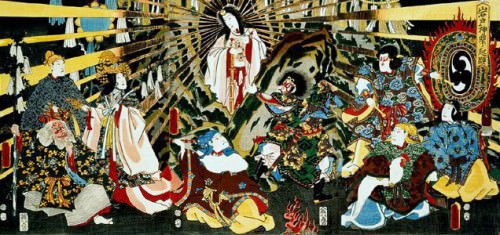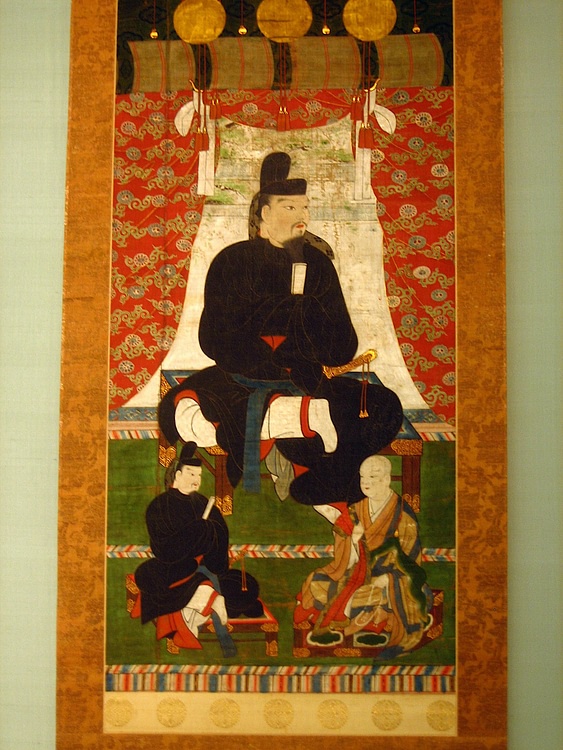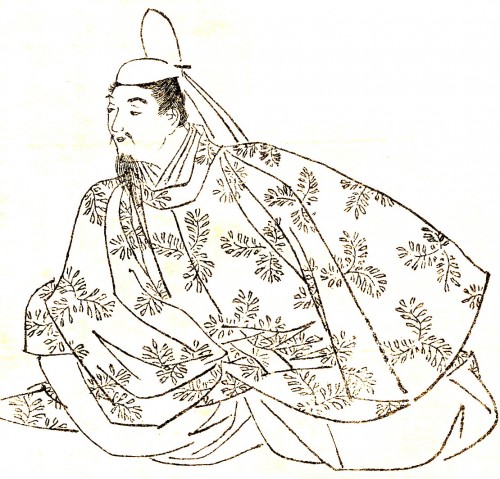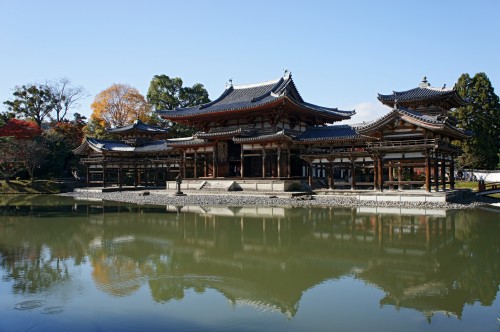Kojiki › Fujiwara Clan » Ancient origins
Articles and Definitions › Contents
- Kojiki › Ancient History
- Fujiwara Clan › Ancient History
Ancient civilizations › Historical and archaeological sites
Kojiki › Ancient History
Definition and Origins

The Kojiki ('Record of Ancient Things') is the oldest book of Japanese history and the oldest text of any kind from Japan.Compiled in 712 CE by the court scholar Ono Yasumaro, the work begins with the gods and the creation of the world, progresses to the genealogy of the early emperors and ends with the reign of Empress Suiko in 628 CE. Not necessarily an accurate historical record, the Kojiki was principally commissioned to establish a clear line of descent from the ruling emperors of the 7th and 8th century CE back to the Shinto gods and the supreme sun goddess Amaterasu.
PURPOSE
During the Nara period (710-794 CE) of ancient Japan, the imperial court was eager to establish its historical connection with the gods, especially the sun goddess Amaterasu, and the founding fathers of the Japanese nation present in Shinto mythology. There was also a concern that oral traditions and unofficial records were constantly being altered and corrupted and an official permanent record was required for posterity. For these reasons, Emperor Temmu (r. 672-686 CE) commissioned the work, although he would not live to see its completion. The court official and scholar Ono Yasumaro was then selected by Empress Gemmei (r. 707-715 CE) to complete the collection and present, in effect, an established orthodoxy of Japanese history which focussed on Shinto mythology and the genealogy of the imperial line and most powerful noble families ( uji ), especially the Yamato clan. Yasumaro drew on earlier written and oral sources, mostly genealogies of powerful clans, and so the work is not only a valuable record of its time but also of earlier, now lost texts and traditions.
CONTENT
The Kojiki was written in Chinese characters but with some Japanese adaptions in terms of sentence structure. There are some elements such as certain gods and names which show influence from China and Korea, but the work is, as a whole, an entirely Japanese construction. Not only a work of prose, the Kojiki, like many later Japanese works, regularly inserts into the text poems and folk songs. The work is divided into three books which deal with gods, early hero-like emperors, and then later emperors in turn, but there is no driving narrative or central character or theme. This absence of structure can increase the difficulty in reading the Kojiki, and there are, consequently, many inconsistencies, disappearing characters, and unanswered questions.
THE KOJIKI IS MOST CELEBRATED FOR ITS DESCRIPTION OF THE 'AGE OF THE GODS' WHEN THE WORLD & JAPANESE ISLANDS WERE CREATED.
The Kojiki is most celebrated for its description of the 'Age of the Gods' when the world and Japanese islands were created and the gods ruled before withdrawing to leave humanity to rule itself. Indeed, there is said to be 8 million gods or spirits ( kami ) in the Kojiki, although, this is traditionally a number associated with 'infinite' so is not to be taken literally. There are creation gods, gods of fire, storms, sea and winds, as well as countless kami manifested in mountains, rivers, trees, and any other natural features of note. There are ancestor gods who head important families and locales and then there is a whole group of demons, evil spirits, and goblins, which inhabit forests, lakes, and graveyards, all awaiting the opportunity to commit mischief on the hapless passer-by.
The stories of the gods are often violent and bloody, with instances of parents killing children and siblings either doing away with each other or forming incestuous relations. The parts of the Kojiki relating the reigns of Japan's early emperors are rather more staid and considered by modern scholars to be historically unreliable. Only with the last 250 years of monarchs is it possible to cross reference some details with contemporary Chinese and Korean sources. Further, the age of the Japanese state, traditionally founded in 660 BCE, is thought exaggerated by its authors so that Japan could claim an equal footing with contemporary China and Korea.

Amaterasu Emerging From Exile
EXTRACTS FROM THE KOJIKI
Original preface by Ono Yasumaro:
So in the dimness of the great commencement, we, by relying on the original teaching, learn the time of the conception of the earth and of the birth of islands; in the remoteness of the original beginning, we, by trusting the former sages, perceive the era of the genesis of Deities and of the establishment of men. ( Kojiki, 5)
Izanami and Izanagi create the first island of Japan:
Hereupon all the Heavenly Deities commanded the two Deities His Augustness the Male-Who-Invites [Izanagai] and Her Augustness the Female-Who-Invites [Izanami], ordering them to “make, consolidate and give birth to this drifting land.” Granting to them a heavenly jewelled spear, they deigned to charge them. So the two Deities, standing upon the Floating Bridge of Heaven, pushed down the jewelled spear and stirred with it, whereupon, when they had stirred the brine till it curdled, and drew the spear up, the brine that dripped down from the end of the spear was piled up and became the island. This is the Island of Onogoro. ( Kojiki, 22)
Susanoo kills the dragon monster and finds the sword which will eventually become part of the Japanese regalia:
…the eight-forked serpent came truly as the old man had said, and immediately dipped a head into each vat, and drank the liquor. Thereupon it was intoxicated with drinking and all eight heads lay down and slept. Then His-Swift-Impetuous-Male-Augustness [Susanoo] drew the ten-grasp sabre, that was augustly girded on him, and cut the serpent in pieces, so that the River Hi flowed on changed into a river of blood. So when he cut the middle tail, the edge of his august sword broke. Then, thinking it strange, he thrust into the split flesh with the point of his august sword and looked, and there was a sharp great sword. ( Kojiki, 75)

Susanoo & the Koshi Dragon
Poem from Princess Nunakawa to Okuninusho:
Come in the dark,When the sun has disappearedAnd the night emergesBehind the green hills.Come smiling, like the morning sunIn all its glory,And take in your embraceMy arms white asRopes of Taku fiber,My breasts, young and soft,As the first fall of snow;Clasp me in your arms.Then you will sleep,Your legs stretched out,Your head pillowed onMy jewellike hands;So do not press your loveToo importunately,Great DivinityOf eight thousand spears.( Kojiki, quoted in Keene, 45)
The death of Jimmu (660-585 BCE), Japan's first emperor:
His Augustness Kamu-nuna-kaha-mimi [Emperor Suwizei] ruled the Empire. Altogether the august years of this Heavenly Sovereign Kamu-yamato-ihare-biko [Emperor Jimmu] were one hundred and thirty-seven. His august mausoleum is on the top of the Kashi Spur on the northern side of Mount Unebi. ( Kojiki, 185)
The unusual physical features of Emperor Hanzei (r. 406-410 CE):
His Augustness Midzu-ha-wake dwelt in the palace of Shibakaki at Tajihi, and ruled the Empire. The length of this Heavenly Sovereign's august person was nine feet two inches and a half [2.8 metres]. The length of his august teeth was one inch [2.5 cm], and their breadth two lines, and the upper and lower correspond exactly, like jewels strung. ( Kojiki, 353)
LEGACY
The Kojiki shortly had a sequel of sorts in the Nihon Shoki ('Chronicle of Japan' and also known as the Nihongi ), which was written by a committee of court scholars in 720 CE. It was designed to address some of the discrepancies in the earlier work and to reassert the genealogies of some of the clans neglected in the Kojiki. The Nihon Shoki also repeats many of the myths of the Kojiki but often from a different viewpoint and with changes in details.
The Kojiki is more than an invaluable history source and entertaining compilation of Japanese mythology, it is the cornerstone of the Shinto religion, its gods and rituals. The work was somewhat neglected in the medieval period but made a stunning comeback to public attention in the 18th century CE when the scholar Motoori Norinaga (1730-1801 CE) famously wrote a 44-volume commentary on the Kojiki in 1798 CE. Motoori's book, the Kojiki-den, would fuel a great revival in the Shinto and see it reinstated as the state religion. The Kojiki continued to be influential in the 19th and 20th century CE, too, with the rise of Japanese nationalism when it was used as evidence that the Japanese people were descended from the gods and so were superior to other races. The book continues to be studied today not only for its mythology but also its insight into early Japanese culture, the beliefs and stylistic approach of its authors, and the evolution of the Japanese language.
This article was made possible with generous support from the Great Britain Sasakawa Foundation.
Fujiwara Clan › Ancient History
Definition and Origins

The Fujiwara clan ( Fujiwara -shi ) was a powerful extended family group which dominated all areas of Japanese government during the Heian Period (794-1185). Founded by Fujiwara no Kamatari in 645 CE, male members held on to key official positions, many acting as regents to the emperor, and ensured their daughters married into the imperial line. By the 12th century CE, Fujiwara power declined as successive emperors abdicated in favour of their own chosen heir while still maintaining their hold on power in retirement. The Fujiwara were ultimately replaced by the rival Taira and Minamoto clans.
FUJIWARA NO KAMATARI
In the 7th century CE the court official Nakatomi, later to become Fujiwara no Kamatari (614-669 CE), became a useful ally to Prince Naka no Oe, and together they staged a coup in 645 CE which deposed the powerful Soga clan who had hitherto dominated government positions and were threatening to usurp the power of the emperor. A series of political reforms were then initiated, known as the Taika Reforms ( Taika No Kaishin ). These reforms were based on the Chinese model of strong central government and they nationalised land, reorganised the court ranking system, forbade the ownership of unauthorised weapons, and attempted to root out corruption. When the Prince became Emperor Tenji (661-671), he gave Nakatomi and his descendants the surname Fujiwara and made him his special minister.
Kamatari's son Fubito (aka Fuhito, 659-720 CE) married the daughter of Emperor Mommu, and his four grandsons each formed the four branches of the Fujiwara clan: Nanke (Southern House), Hokke (Northern House), Shikike (Ceremonials House), and Kyoke (Capital House). The Fujiwara line was now firmly established and they would keep a tenacious grip on power as they not only dominated policy and government bodies such as the household treasury office ( kurando - dokoro ) and Council of State but also managed to marry off their daughters to emperors.
THERE WERE 21 FUJIWARA REGENTS FROM 804 CE TO 1238 CE.
FUJIWARA NO YOSHIFUSA
One such figure was Fujiwara no Yoshifusa (804-872 CE) who was the clan leader ( uji no choja ) from 858 CE. He put his seven-year-old grandson on the throne in 858 CE and then formally became his regent in 866 CE. This was the first time a regent had not been of royal blood and it established a trend that would continue into the 11th century CE. The Fujiwara, and especially the Northern House, now had direct control over the emperors, and so there was no need to remove the institution, although individuals who proved less than cooperative could be forced into abdication and one or two emperors disappeared in mysterious circumstances or ended up in monasteries. In addition, the clan's own private militia ensured that their position was never seriously threatened by outsiders.

Fujiwara no Yoshifusa
INTERNAL RIVALRIES
Fujiwara control was almost total but there were threats from within. Rivals jockeyed for position within the state apparatus and in the provinces where government control was weaker. The northern Fujiwara, for example, had established a prosperous administrative base at Hiraizumi in northern Honshu and their dominance was repeatedly challenged by the other branches of the clan. One notable rebellion was led by the clan rebel Fujiwara no Sumitomo in the Iyo province on Shikoku. He commanded a large pirate fleet that plagued the sea between Japan and mainland Asia, and he became a hero to the local hard-pressed peasants when he attacked government granaries. The rebellion was soon quashed, though, following Sumitomo's death in 941 CE. Still, the Fujiwara was now such a widespread organisation with so many branches it was almost inevitable that there would be disputes over who should be its leading figure and have the coveted responsibility and control of the clan's lands, income, and civil appointments. The clan also controlled many temples and shrines, including such jewels as Byodo-in at Uji and the Fujiwara family temple, the Kofuku-ji complex in Nara, founded in 669 CE.
FUJIWARA NO MICHINAGA
Another important Fujiwara figure was Michinaga (966-1028 CE) who became the clan's leader in 995 CE. During his 30-year reign as the most powerful individual in Japan, he married off four daughters to four emperors and so eventually came to have an impressive four emperors as grandsons. The Fujiwara were at their zenith and Michinaga could claim in his famous poem: “No waning in the glory of the full moon - this world is indeed my world!” (Whitney Hall, 70). Michinaga retired from politics and became a Buddhist monk in 1019 CE - he had already prepared the way by founding the Hojoji temple - but he still pulled the strings of power through his son Yorimichi (992-1074 CE). When he died in 1027 CE, Michinaga was said to have clasped in his hands strings of a different kind, silk cords which ran to several statues of the bodhisattva Amida in the hope that they would pull him to the Pure Land of the Buddhist afterlife. Michinaga's life became the subject of the Eiga monogatari, an 11th century CE history.

Phoenix Hall, Byodo-in
DECLINE IN POWER
The dominance of the Fujiwara was not quite total and did not always go unchallenged. One of the first attempts by the emperors to reassert their power and independence was by Emperor Uda. He sought to break the Fujiwara monopoly by promoting one Sugawara Michizane (845-903 CE), an outsider of lowly social rank, to the high position of Minister of the Right and a member of the Council of State in 899 CE. In 901 CE, the Fujiwara fought back and concocted an accusation of treason against Sugawara with the result that he was effectively exiled. Sugawara would get his revenge when certain disasters befell the palace and state following his death, ultimately even being officially deified as the Shinto god of scholarship under the honorary title of Tenjin. Nevertheless, for the Fujiwara, normal service had resumed.
Emperor Shirakawa (r. 1073-1087 CE) attempted to assert his independence from the Fujiwara by abdicating in 1087 CE and allowing his son Horikawa to reign under his supervision. Shirakawa's own father, Emperor Go-Sanjo (r. 1068-1073 CE) had done exactly the same but had died a year after abdicating. Shirakawa, on the other hand, ruled behind the scenes for over three decades. Emperors, from that time on, also created their own bureaucracy of power similar to that of the Fujiwara clan.This strategy of 'retired' emperors still, in effect, governing became known as 'cloistered government' ( insei ) as the emperor usually remained behind closed doors in a monastery.
RETIRED EMPERORS & RIVAL CLANS WITH THEIR ARMED RETAINERS BEGAN TO THREATEN THE DOMINANCE OF THE FUJIWARA CLAN.
In the provinces, new forces were emerging which would challenge the dominance of the Fujiwara even more seriously. Left to their own devices and fuelled by blood from the minor nobility produced by the process of dynastic shedding (when an emperor or aristocrat had too many children they were removed from the line of inheritance), two important groups evolved, the Minamoto (aka Genji) and Taira (aka Heike) clans. With their own private armies of samurai, they became important instruments in the hands of rival members of the Fujiwara clan's internal power struggle which broke out in the 1156 CE Hogen Disturbance.
In 1156 CE the death of the retired emperor Toba caused a bid for power from two rival groups within the Fujiwara clan, each with their own claimant to be next emperor. Tadamichi Fujiwara supported Go-Shirakawa while his brother Yorinaga sided with the retired emperor Sutoku. The Taira clan sided with the Go-Shirakawa and the Minamoto clan sided with Sutoku, although things were made even more complicated when Yoshitomo, son of the Minamoto leader Tameyoshi, sided with Go-Shirakawa.After the violence rather euphemistically called the Hogen Disturbance ( Hogen No Ran ) was over, Go-Shirakawa and his supporters had won the day.
The Taira, led by Taira no Kiyomori, eventually swept away all rivals and dominated government for two decades. However, in the Genpei War (1180-1185), the Minamoto returned victorious, and the clan leader, Yoritomo, was given the title of shogun by the emperor. Yoritomo's rule would usher in the Kamakura Period (1185-1333 CE), also known as the Kamakura Shogunate, when Japanese government became dominated by the military.
The Fujiwara may have lost political power but the clan continued as an important aristocratic family with many members continuing to hold titled positions, even if those roles had no direct bearing on government. The provinces were another redoubt for Fujiwara members no longer able to acquire through patronage key positions at court. In later times the clan produced some noted writers and poets, amongst them Fujiwara no Sadaie who in 1205 CE compiled the Shin Kokinshu, an imperial poetry collection.
This article was made possible with generous support from the Great Britain Sasakawa Foundation.
LICENSE:
Article based on information obtained from these sources:with permission from the Website Ancient History Encyclopedia
Content is available under License Creative Commons: Attribution-NonCommercial-ShareAlike 3.0 Unported. CC-BY-NC-SA License